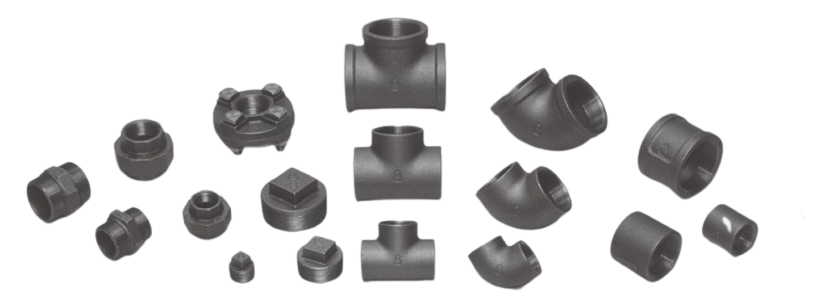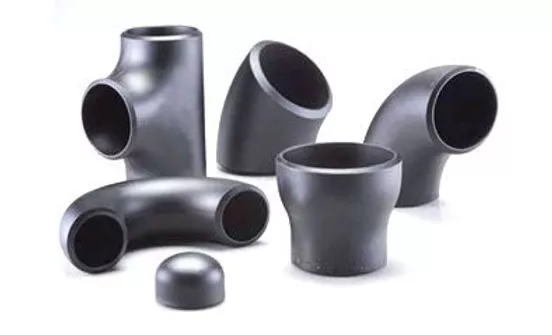Pipe Fittings (Carbon Steel)
Obviously, pipe fittings are attached to the end of pipes that allow them to change direction, control the flow, and change the diameter of the pipe. Being a non-trivial part of plumbing and piping systems, consulting us with your need is definitely advised to save yourself time, money, materials, and headaches.
Pipe fittings are widely demanded in any piping and plumbing systems used in industrial and commercial applications. Fittings allow pipes to be joined or installed in the appropriate place and terminated or closed where necessary. Fittings are available in various shapes and sizes. They can be expensive, require time, and have different materials and tools to install. They are an essential part of piping and plumbing systems. There are thousands of specialized fittings manufactured. Each type of pipe or tube requires its own type of fitting, but usually, all pipe fittings share some common features. Pipe fittings are available everywhere where plumbing materials are sold.
Tysseer trading
Our Suppliers
Tysseer trading
Pipe Fittings Types


Pipe Fittings Types & Their Functions
1. Elbows: Such pipe fittings are used to change the direction of the flow. They are majorly available in two standard types – 90 and 45-degree angles owing to their high demand in plumbing. The 90-degree elbow is primarily used to connect hoses to water pumps, valves, and deck drains, while the 45-degree elbow is mostly used in water supply facilities, electronic and chemical industrial pipeline networks, food, and air-conditioning pipelines, garden production, agriculture, and solar-energy facility.
Available in: Acrylonitrile Butadiene Styrene (ABS plastic), polyvinyl chloride (PVC), chrome-plated brass, chlorinated polyvinyl chloride (CPVC), stainless steel, malleable (galvanized and black), and copper.
2. Couplings: A coupling is a pipe fitting used to stop leakages in broken or damaged pipes. The pipes to be connected should be of the same diameter. The two kinds of couplings used in plumbing are regular coupling and slip coupling. The regular coupling is arranged between the two pipes to prevent further leakages with the help of rubber seals or gaskets on both sides. The slip coupling itself contains two pipes to repair the damaged lengthy pipes.
Available in: ABS, brass, copper, chrome-plated brass, CPVC, PVC, malleable (galvanized and black), and stainless steel.
3. Union: This type of pipe fitting is almost similar to coupling in terms of functions, but just with a difference, i.e. a union can be removed easily at any time while the coupling cannot. A variety of dielectric unions are used to join pipes made of different materials to avoid any kind of galvanic corrosion between them. These pipe fittings comprise nut, female and male-ended threads.
Available in: Brass, copper, chrome-plated brass, malleable (galvanized and black), PVC, CPVC, and stainless steel.
4. Adapters: Adapters are connected to pipes to either increase their lengths or if pipes do not have appropriate ends. These pipe fittings make the ends of the pipe either male or female threaded as per the need. This permits unlike pipes to be connected without any need for an extensive setup. They are mostly used for PVC and copper pipes.
5. Nipple: This is a short butt of a pipe that works as a connection between two other fittings having male threads. A close nipple is a type of pipe fitting having continuous threading on them. They are mostly used in hoses and plumbing.
Available in: Brass, chrome-plated brass, malleable (galvanized and black), PVC, copper, and stainless steel.
6. Reducer: This pipe setting is used to reduce the flow size of the pipe from the bigger to the smaller ones. There are two kinds of reducers- concentric reducer and eccentric reducer. The former one is in the shape of a cone used for gradual reduction of the size of the pipe. The latter one has one edge facing the mouth of the connecting pipe reducing the chances of air accumulation.
7. Tee: This T-shaped pipe fitting used in the plumbing system has one inlet and two outlets arranged at an angle of 90 degrees to the main pipe. This kind of fitting is used to connect the two pipes and make their flow direction as one. If all the three sides of this fitting are the same in size, it is called equal tee, otherwise unequal tee.
Available in: ABS, copper, CPVC, PVC, brass, chrome-plated brass, malleable (galvanized and black), and stainless steel.
8. Cross: This type of pipe fitting contains four openings in all four major directions. This fitting is adjoined to four pipes meeting at a common point. There is either one inlet and three outlets or vice-versa to flow water or any other liquid in four different directions. These kinds of pipe fittings are commonly used in fire sprinkler systems.
Available in: PVC, brass, malleable (galvanized and black), and stainless steel.

9. Flanges: A flange is another pipe fitting used to connect pipes, pumps, valves, and other components to form a full-fledged piping system. They come with the flexibility of easily cleaning or inspecting the whole system from within. They are fixed to the pipes using welding, threading, or screwing techniques and then finally sealed with the help of bolts. They are used in residential pump systems and majorly for industrial purposes.
10. Caps & Plugs: Both these pipe fittings are used to close the ends of the pipe either temporarily or permanently. The plugs are fitted inside the pipe and threaded to keep the pipe for future use. There are a good number of ways a cap can be applied to the pipe like soldering, glue, or threading depending on the material of the pipe.
Available in: ABS, brass, copper, chrome-plated brass, malleable (galvanized and black), CPVC, PVC, and stainless steel.
11. Bushings: These pipe fittings are used to combine pipes of different sizes together by decreasing the size of the larger fitting to the size of the smaller pipe. Bushings are not always threaded inside out and occupy very little space in comparison to a union or coupling used for the same purpose.
Available in: ABS, chrome-plated brass, copper, brass, CPVC, PVC, stainless steel, and malleable (galvanized and black).
12. Wyes: Such types of pipe fittings are used in drainage systems and have a branch line at 45 degrees to keep the flow of water smooth. When the sanitary tees fail to work in a horizontal connection, such cases need a wye.
Available in: Brass, ABS, and PVC.
13. Valves: Valves are used in the plumbing system to stop the flow of gases or liquids. There are three types – throttling, isolation, and non-return. The isolation valves are used to disconnect a part of the piping system temporarily for maintenance or repair. The throttling valves are used to regulate the amount of pressure of a liquid in a pipe; they can also withstand the stress caused by this process.
14. Barb: A barb is another useful pipe fitting used in the plumbing system that connects flexible tubing to pipes. It has a male-threaded end on one side that connects with the female threads, and the other end has a single or a multi-barbed tube that is inserted in the flexible tubing.
15. Diverter tee: This kind of tee-shaped pipe fitting is commonly used in pressurized hydronic heating systems to redirect a part of the flow from the mainline to the side branch connected to a heat exchanger.
16. Olet: These fittings are used when the standard size of the fittings fails to serve the purpose. How are pipe fittings connected to pipes?
Pipe fittings are either male fittings or female fittings. In threaded pipe fittings, female threads are on the inside while male threads are on the outside. Pipe fittings that have one female end and one male end are called street fittings. Pipe fittings are used to connect pipes or tubes in two ways:
- By threading: Threaded pipes screw together to connect or join. Generally, metal pipes are threaded and they have threaded fittings.
- By slip fit: Slip fit pipes use sleeves that slip into one another. The plastic pipes are either threaded or slip fit.
Purpose of a pipe fitting:
The basic purposes of any pipe fitting are as follows:
- Connecting the bores of two or more pipes or tubes.
- Connecting pipe sections.
- Connecting a pipe to a different apparatus.
- Changing the direction of fluid/liquid flow.
- Maintaining or regulating the flow.
- Closing and sealing a pipe.
Benkan
Benkan Co Ltd, the world-famous manufacturer of high-quality Butt Weld Fittings, with more than thirty years of experience , We maintain delivery, with competitive pricing, building credibility, and continuously improving the effectiveness of our Quality Management System.




